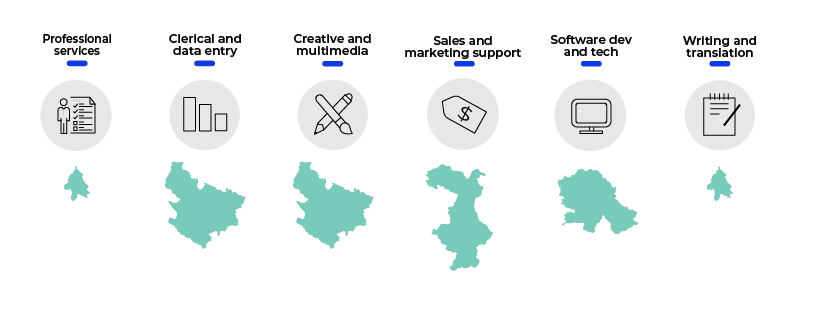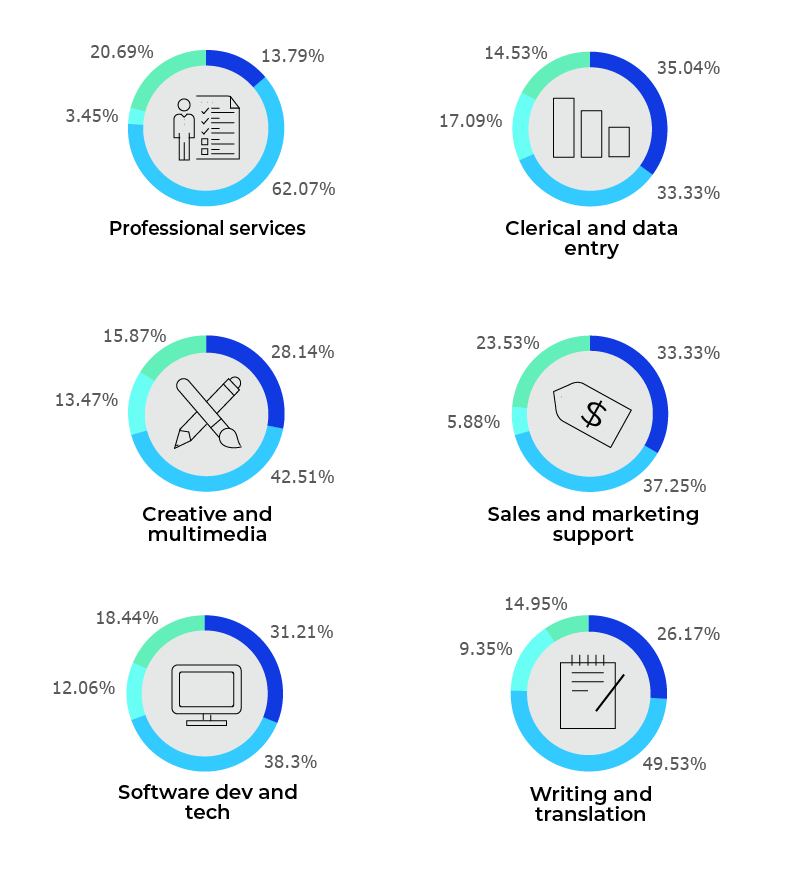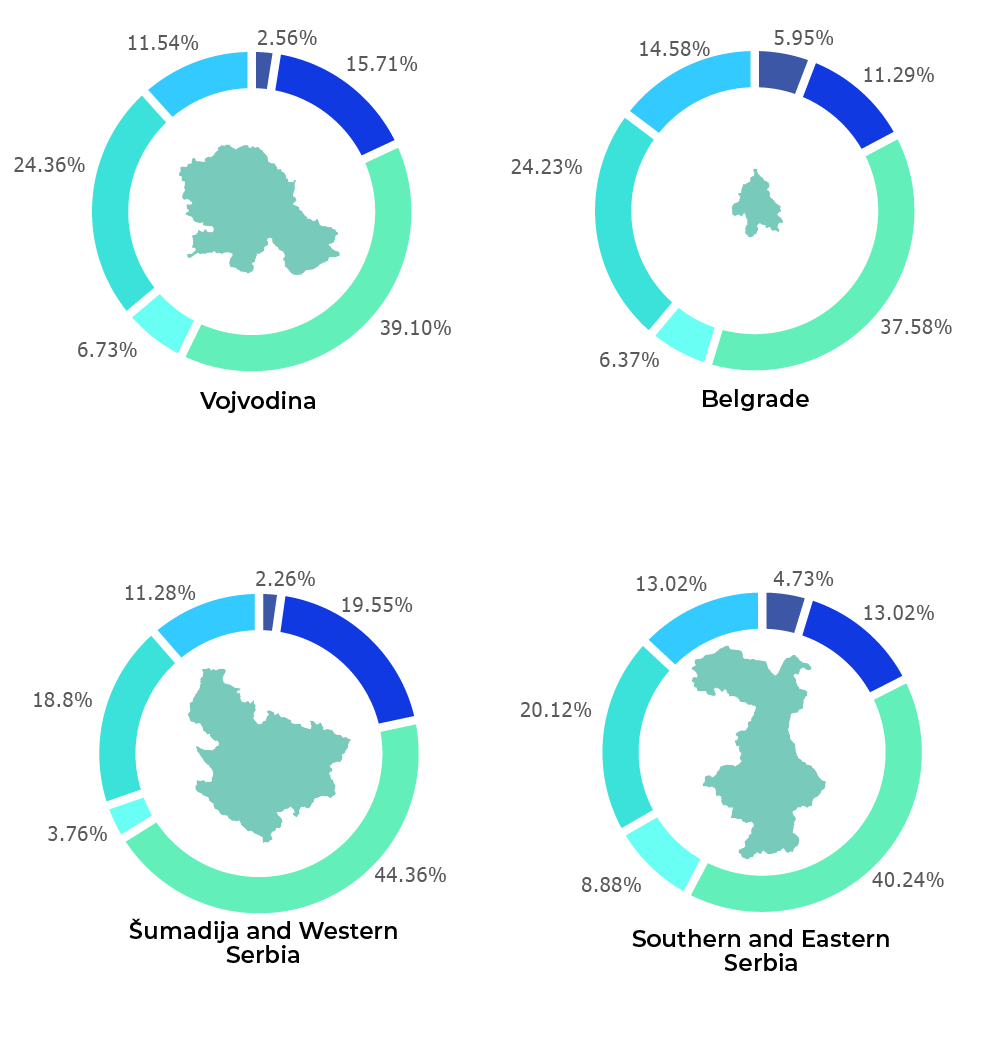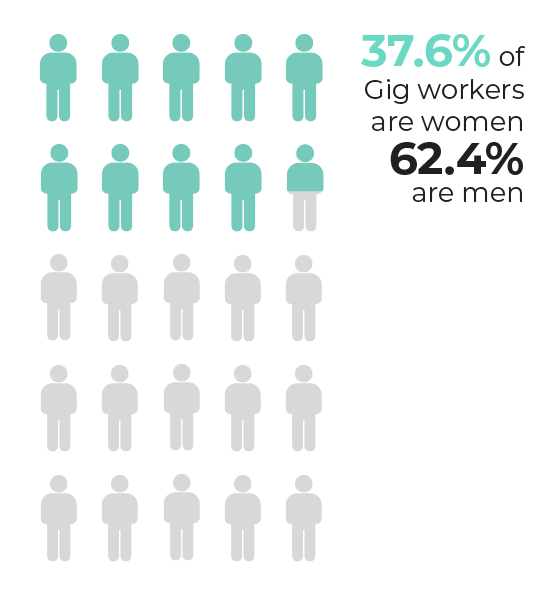Covid-19 report, October 2020
October’s GigMetar monitoring reveals that the supply of gig labour from Serbia has remained relatively stable after the initial shock of the pandemic. The increase in registered freelancer profiles globally and the slowing demand for their services have put Serbian gig workers into a much more competitive global market since the pandemic began.
Apart from greater competition and the relatively stable, if lower, demand for gig work, except in the software development and technology sector, Serbian freelancers are facing the government’s regulatory efforts to collect taxes on income from this type of work. Even though this move by the authorities has created much debate and pushback, identical trends are observable in many European countries, with some nations rather far advanced along this path and working closely with technology companies that own online labour platforms.
Many reasons have contributed to the relative stability of Serbia’s gig work market during the pandemic. Some are intrinsic to the country and others are global. The contraction in demand for gig labour globally on the key markets has made it more difficult to get work, especially for new, inexperienced freelancers. According to the findings, where we have observed individuals who worked in the past two years and new entrants without working experience, it seems that the coronavirus outbreak has halted significant pre-pandemic growth of the market whilst stopping short of causing it substantial damage. The percentage of those who found work on the platforms for the first time in the first nine months of 2020 is 22.5 % lower compared to the same period of 2019. Put differently, nearly as many individuals first found work in the initial 9 months of 2020 as in the whole of 2018. Gig work in Serbia exploded over the past three years, as evidenced by the fact that 61.51 percent of all platform workers got their first jobs via platforms in this three-year period, considerably more than over the whole decade preceding 2018. Notably, the oldest gig worker in our sample started freelancing in March 2008. He is a man from Belgrade, a software developer with the skills characteristic for gig workers in professional services.

% OF GIG WORKERS BY ADMINISTRATIVE DISTRICT
The regional distribution of gig workers has not been affected by the Covid-19 pandemic. The distribution of workforce across the four Serbian regions has remained virtually the same as in the past surveys. Close to one in three freelancers (28,34%) are based in Vojvodina, and nearly one-half of the gig workforce (44,23%) reside in Belgrade. Southern and Eastern Serbia and Šumadija and Western Serbia show minimal changes, which may however be attributed to changes in the methodology. Gig workers remain the least numerous in these two regions: only slightly more than 12 percent of all freelancers are based in Šumadija and Western Serbia, with Southern and Eastern Serbia being home to only somewhat more, at 15 percent. Interestingly, tracking gig workers in Serbia over the past year has shown they are relatively closely connected to their home region or town/city.
Apart from concentrations of this workforce in administrative hubs and large urban centres across the four regions (Belgrade, Novi Sad, Niš, and Kragujevac), relatively few other communities can boast larger numbers of freelancers, and platform workers are widely dispersed across the country. Put differently, the four major cities account for 70 percent of the entire freelancer population, with just another 7 towns being home to more than 1 percent of the gig workforce each. The scale of this geographical dispersion is best evidenced by the finding that freelancers are based in as many as 117 Serbian cities and towns. In Vojvodina, gig workers show (some) concentration in Subotica (2.5 percent), Zrenjanin (1.1 percent), and Pančevo (1.5 percent). Apart from Niš, the Southern and Eastern Serbian freelancer population is more densely concentrated only in Leskovac (home to 1.6 percent). The gig workforce is scattered across several towns in Šumadija and Western Serbia, including Kraljevo (1.3 percent), Čačak (1.3 percent), and Užice (1 percent). Vojvodina and Šumadija and Western Serbia reveal more geographical diversity.
All regions except Belgrade contain disproportionately large populations of gig workers who have attested experience with platform work (measured by registered work experience/history). Looking at the whole population of gig workers, both with and without experience, the relative share of gig workers in Belgrade exhibits the strongest growth. This clearly indicates that Belgrade is the largest pool of prospective new platform workers.

GIG WORKERS BY OCCUPATION
.

The figures below show the distribution of gig workers in Serbia by occupation, according to the Online Labour Index (OLI) classification. The October survey confirmed the dominance of creative and multimedia services and software development. Nearly one in five platform workers are engaged in software development, and more than 4 in 10 work in creative and multimedia services. Interestingly, nearly one-quarter of all creative and multimedia freelancers have no prior experience with working online, which on the one hand indicates how difficult it is to find work on platforms, and on the other how attractive the platform economy is for new entrants. The ratio of experienced software developers is even lower, with a ratio of 0.8 new entrants to gig workers with a record of platform work. The findings are in line with those of the OLI index, which reveals that the pandemic has increased global demand for IT talent, with the Serbian IT professionals market reacting to the new opportunities.
Looking at those who had work in October, the key conclusion is that this group were more likely to be active in less well-paid occupations such as data entry and sales and marketing support. A total of 44.76 percent of the entire gig workforce were engaged on specific projects in October. The lowest rate of requests for projects was identified in software development and technology, where one in three freelancers (33 percent) were engaged, with sales and marketing support and clerical and data entry seeing the most work (50 percent). Multimedia and creative freelancers had slightly fewer projects, at 48.7 percent, followed by gig workers in the writing and translation sector, at 45 percent, and those in professional services, at 42 percent. The relative shares of individual occupations in the workforce have remained fairly stable. Professional services account for 4.3 percent of the total, data entry and clerical for 13.97 percent, creative and multimedia services dominate with 39.25 percent, sales and marketing support account for 6.43 percent, software development and technology for 22.97 percent, and writing and translation for 13.05 percent.
REGIONAL GIG WORKERS AS % OF TOTAL, BY OCCUPATION
The October survey revealed that relationships identified in the previous measurement waves have generally remained stable. The City of Belgrade has retained the largest share of freelancers across all occupations when compared to other parts of the country, which was only to be expected as the Serbian capital is home to the largest gig workforce and constantly attracts young and educated individuals from across the country. Comparing the relationship between the shares of freelancers in the total gig workforce by region and by occupation reveals that some regions enjoy comparative advantages. The only constant is that platform workers based in Belgrade outnumber those from other regions across all occupations, since the overwhelming majority of gig workers are located in the capital city.

Belgrade enjoys relative comparative advantages in professional services, software development and technology, and writing and translation. Professional services clearly lead the field (more than 62% of all gig workers in this occupation are from Belgrade), but also employ the lowest proportion of freelancers, at no more than 4.36 percent of the total workforce. Vojvodina’s comparative advantages lie in clerical and data entry, sales and marketing support, and software development. This region is best placed for clerical and data entry, being home to nearly 1 in 3 of all Serbian gig workers in this occupation and lagging behind Belgrade by less than 4 percent. The small scale of this difference is especially obvious if contrasted with the fact that professional services freelancers based in Belgrade outnumber those from Vojvodina by a factor of nearly 4, or with the fact that the capital is home to almost twice as many gig writers and translators. The figures for the remaining two occupations are only slightly above the average, so Vojvodina does not enjoy a major comparative advantage in these areas. Most gig workers in Southern and Eastern Serbia are active in professional services, the creative and multimedia industry, and sales and marketing support. This region enjoys the greatest edge in sales and marketing, with one in five of all Serbian freelancers in this field based here. Professional services are another strong point for this part of Serbia, as its share of platform workers in this occupation is the same as Vojvodina’s, even though the total gig workforce in Vojvodina is nearly twice as large. Western Serbia and Šumadija has the smallest gig worker population that is focused on clerical and data entry and multimedia and creative services. The clerical sector is the strong suit of this region, which is also the only region with a smaller total workforce that has a greater share of freelancers in a particular occupation compared to more populous areas. Even though the freelancer population of Southern and Eastern Serbia is larger than that of Western Serbia and Šumadija by more than 3 percent, its share of clerical gig workers is also smaller by close to 3 percent.
All gig workers from the sample


Gig workers with registered income

A look at the population with a track record of platform work – those who had previously earned income from platform work – reveals important changes in comparative advantages relative to the overall workforce as discussed above. Here, professional services are found to be dominant in Belgrade, which also loses its comparative advantage in software development, but gains a slight edge in creative and multimedia services, and a nearly identical one in writing and translation. A particularly interesting finding is the supremacy of Vojvodina over all other regions when it comes to clerical and data entry services, indicating that this area is home to the largest concentration of freelancers in this sector. Focusing only at experienced platform workers reveals an even greater advantage for Vojvodina in sales and marketing support. Southern and Eastern Serbia enjoys a greater edge for professional services, being home to more workers in this sector than Vojvodina, and extends its lead in sales and marketing support, where close to 1 in 4 of all freelancers are based in this region. Šumadija and Western Serbia show no difference in terms of comparative advantage regardless of which gig worker population is observed.
% OF REGIONAL GIG WORKERS BY OCCUPATION

The figures reveal the distribution of gig workers by occupation in each region. Interestingly, the largest proportion of freelancers in each region work in creative and multimedia services, whilst the smallest share provide professional services. The remaining occupations are represented to varying degrees in each region, with no major differences in evidence other than the negligibly small number of freelancers in the professional services sector in Šumadija and Western Serbia.

GIG WORKERS BY GENDER
The relatively large share of women is a particular hallmark of the Serbian gig workforce. As many as 4 of every 10 freelancers with experience of platform work are women.
Forty percent of all platform workers who were working on projects at the time the data were collected (in October) were women, and 60 percent were men. Covid-19 has apparently had no gender-biased impact on the employment of either women or men freelancers, as employment levels by gender correspond to proportions in the overall gig workforce.
It ought to be noted, however, that the October measurement revealed a much smaller share of new women platform workers, at 30.5 percent, perhaps hinting at a downward trend over time.
Moreover, this percentage also corresponds to the proportion of women gig workers found in earlier measurements, lending more weight to the assumption that women freelancers were taking on platform work less frequently than men, despite their respectable share in the overall population.

% OF GIG WORKERS BY GENDER AND OCCUPATION

Gender and occupation influence the interpretation of data in two ways, depending on whether the freelancers have working experience (as indicated by income earned through platform work) or not. Looking at the total gig workforce, women are more numerous in clerical and data entry and writing and translation services. However, if only freelancers who have experience with platform work are considered, women are seen to dominate professional services as well. In this case, women and men are each over-represented in an equal number of occupations. Nevertheless, women enjoy only a slight advantage in clerical and data entry and professional services, regardless of whether the entire workforce or only experienced gig workers are considered. Exceptionally, women far outnumber men – by a factor of more than two – in writing and translation. By contrast, men are greatly over-represented in creative and multimedia services, where they outnumber women nearly 2 to 1, and particularly in software development, where there are more than 7 men to each woman freelancer.
TOTAL INCOME BY GENDER

Figures on gig worker income by gender reflect the gender structure of the gig population, which is dominated by men, and, to a lesser extent, differences in hourly rates, which are on average higher for men. Even though women account for more than 40 percent of the workforce, their share of income amounts to 35.10 percent. These values are aggregates, and as such they are subject to minor fluctuations over short periods of time since GigMetar surveys began in December 2019. Furthermore, Covid-19 has impacted women and men identically regarding their gig engagement, bringing no changes in this area.
HOURLY RATES, IN US$, BY GENDER AND OCCUPATION

Average hourly rates, the quoted prices formally demanded by Serbian gig workers for their services, have fallen, and this is where the adverse impact of the pandemic is at its most visible.
The moderate upward trend consistently recorded by previous measurements has been halted and even reversed to some extent. The decline was caused chiefly by the lower prices quoted by new entrants, whose median hourly rates were lower by as much as 33 percent when compared with experienced gig workers. Average hourly rates have remained at US$ 19.40 in the experienced worker cohort. However, the median hourly rate for Serbian freelancers is US$ 15, one-quarter lower than the median rate in the US, the world’s largest gig labour market. Major gender-based differences remained in evidence. The median male gig worker was commanding an hourly rate greater by nearly US$ 5 than the median female worker (who required US$ 13 for an hour of her work). The primary cause for this divergence lies in the fact that men dominate better-paid professions. The difference seems to have increased relative to previous measurements, as in October women registered hourly rates lower by 23.6 percent than those required by men. The pandemic seems to have largely halted the convergence between male and female incomes that had been in evidence both in Serbia (see the previous GigMetar COVID-19 report) and globally. Interestingly, the difference in hourly rates is the smallest in the most numerous segment of the gig workforce, those active in creative and multimedia services. Nevertheless, men are demanding higher hourly rates in all occupations and regardless of whether they are experienced freelancers or new entrants to the gig economy. Moreover, there is a greater difference between rates quoted by experienced workers and those of the overall gig workforce. This may corroborate the view that, even though platforms are gender-neutral by design and match employers with workers solely based on price, they are still unable to eliminate barriers in candidate selection. Differences here are at their most tangible in professional services and software development.
_____________________________________________________
Recommended citation: Anđelković, B., Jakobi, T., Ivanović, V., Kalinić, Z. & Radonjić, Lj. (2020). Gigmetar Serbia, October 2020, Public Policy Research Center, http://gigmetar.publicpolicy.rs/en/serbia3/.
PREVIOUS REPORTS
HOW GIGMETAR WORKS
GigmetarTM is the first instrument that describes the geography of digital work in Serbia and the region in terms of gender, income, and most common occupations. It is a result of the efforts made by the Public Policy Research Centre (CENTAR) to shed more light on the work on online platforms.

ABOUT US
The Public Policy Research Centre (CENTAR) is a team of innovative researchers and digital enthusiasts investigating the future of work and development of the digital economy in Serbia and South-East Europe.
Contact: gigmetar@publicpolicy.rs



